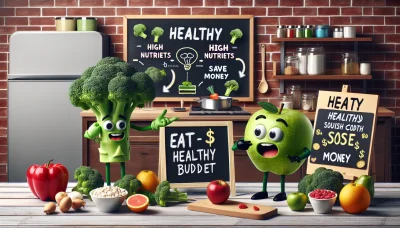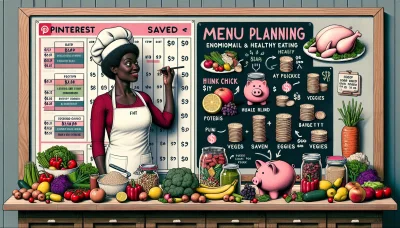Humis Quiz
Test Your Knowledge
Question of
Understanding Humis: A Staple in Healthy Eating
Humis, often spelled as "hummus", is a popular dish with roots deeply embedded in Middle Eastern cuisine. It is a creamy spread made primarily from cooked and mashed chickpeas blended with tahini, olive oil, lemon juice, garlic, and various seasonings. This rich, savory paste has been a staple in healthy eating due to its nutritious profile, offering a good source of protein, fiber, and essential vitamins and minerals. Its origins can be traced back to ancient times, and it has since become a beloved food item across the globe, enjoyed as a dip, spread, or even a meal in itself.
Nutritional Benefits of Humis
- Protein: Contributes to muscle growth and repair.
- Fiber: Aids in digestion and promotes a healthy gut.
- Iron: Essential for the production of healthy red blood cells.
- Folate: Important for DNA synthesis and repair.
- Phosphorus: Supports the formation of bones and teeth.
- Zinc: Boosts the immune system and promotes wound healing.
How to Incorporate Humis into Your Diet
Humis, a nutritious and flavorful addition to any meal, offers a versatile option for enhancing your daily diet. Its rich texture and health benefits make it an excellent choice for those looking to add more plant-based protein to their meals. Whether you're a seasoned humis enthusiast or new to its delights, discovering ways to incorporate it into your breakfast, lunch, and dinner can transform your eating habits and introduce a new layer of flavor to your dishes.
- Breakfast: Spread humis on whole-grain toast and top with avocado slices for a hearty and healthy start to your day.
- Lunch: Use humis as a flavorful dressing for your salads or as a replacement for mayonnaise in sandwiches and wraps.
- Dinner: Mix humis into your pasta sauces or use it as a base for a protein-packed pizza topping.
DIY Hummus Recipes for Beginners
Discover the joy and health benefits of making your own hummus at home. Not only does homemade hummus taste fresher, but it also allows you to control the ingredients, ensuring you can avoid preservatives and additives found in many store-bought versions. Here are some easy-to-follow recipes to get you started:
- Classic Hummus: Start with chickpeas, tahini, lemon juice, garlic, and olive oil for the traditional hummus experience.
- Roasted Red Pepper Hummus: Add roasted red peppers to the classic recipe for a sweet and smoky flavor.
- Avocado Lime Hummus: Blend ripe avocados and lime juice with your base hummus for a creamy, tangy twist.
- Beet Hummus: Incorporate roasted beets for a vibrant, earthy version that's as beautiful as it is delicious.
- Spicy Black Bean Hummus: Use black beans instead of chickpeas and add jalapeños or your favorite chili for a kick.
Each of these recipes not only offers a delightful taste experience but also packs a nutritious punch. Homemade hummus is rich in protein, fiber, and healthy fats, making it a perfect snack or addition to any meal. Enjoy the process of creating and the health benefits that come with these homemade hummus recipes.
The Role of Humis in Weight Management
Humis, a popular dish made from chickpeas, tahini, olive oil, lemon juice, and garlic, can play a pivotal role in weight management and loss plans. Its high fiber content is essential for healthy digestion and helps promote a feeling of fullness, which can reduce overall calorie intake by curbing the appetite. Additionally, humis is relatively low in calories yet rich in protein, making it an excellent food choice for those looking to manage their weight without sacrificing nutritional value. Integrating humis into meals can support weight loss goals while ensuring the body receives necessary nutrients.
Comparing Humis Varieties
| Variety | Nutritional Values (per 100g) | Flavor | Best Uses |
|---|---|---|---|
| Traditional | Calories: 166, Protein: 8g, Fat: 9.6g, Carbohydrates: 14.3g, Fiber: 6.0g | Rich, creamy, with a hint of lemon and garlic | Dips, spreads, with fresh vegetables |
| Red Pepper | Calories: 174, Protein: 5.4g, Fat: 12g, Carbohydrates: 13g, Fiber: 4.0g | Sweet, smoky with roasted red pepper | Sandwich spreads, with grilled meats |
| Garlic | Calories: 169, Protein: 7.9g, Fat: 10g, Carbohydrates: 14.9g, Fiber: 5.1g | Strong, pungent garlic flavor | Garlic bread spreads, with pita chips |
| Others | Varies | Varies | Varies |
Frequently Asked Questions About Humis
- What are humis?
- Humis are a type of fermented food product known for their rich flavor and health benefits. They are often made from a blend of grains, legumes, and sometimes vegetables.
- Can humis cause allergic reactions?
- Yes, depending on the ingredients used in the humis, they can cause allergic reactions. Common allergens in humis include soy, wheat, and nuts. Always check the label if you have food allergies.
- How long can I keep humis before they go bad?
- Unopened, humis can last for several months when stored in a cool, dry place. Once opened, it's best to consume them within 1-2 weeks, and they should be kept refrigerated to maintain freshness.
- Are humis vegan?
- Most humis are vegan as they are primarily made from plants. However, some varieties may include animal-derived ingredients for flavoring, so it's important to read the label if you follow a vegan diet.
- How can I serve humis?
- Humis can be served in a variety of ways. They make a great addition to salads, sandwiches, and wraps. They can also be enjoyed as a dip with vegetables or crackers, or used as a flavorful spread on toast.
- Do I need to cook humis before eating?
- No, humis are typically ready to eat straight from the package. However, they can be warmed up if preferred, especially when added to hot dishes.












